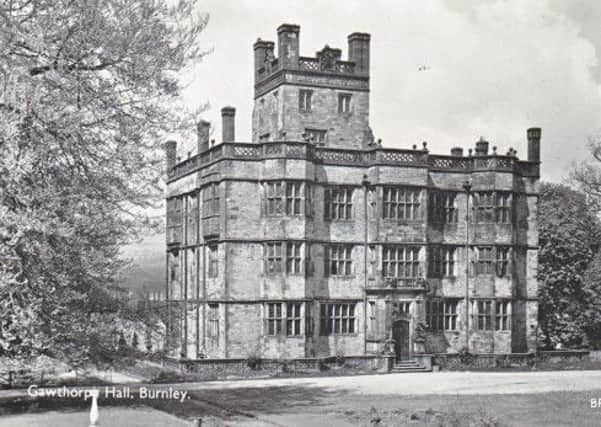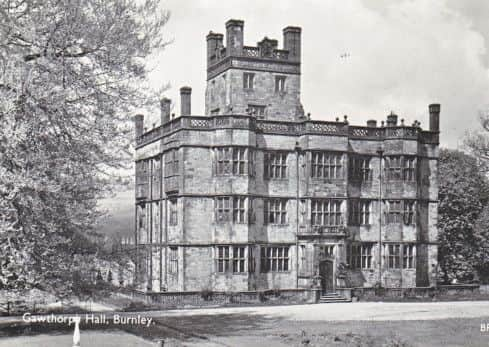Photos: The history of Gawthorpe Hall


The first is owned and managed by Burnley Council, which also has a significant, and often unacknowledged, role in the financing of Queen Street Textile Museum, Briercliffe.
Gawthorpe is also run by a council, but this time it is Lancashire County Council which is partnered by the National Trust.
Advertisement
Hide AdAdvertisement
Hide AdIn fact the house is promoted as a National Trust property and, though it is one of their smaller houses, it is not without interest.


Gawthorpe Hall, along with Towneley Hall, Shuttleworth Hall and Queen Street Mill, all in Burnley, are listed by English Heritage as Grade 1, the highest listing. This makes these buildings of national, even international, importance and, in addition to this, the Great Barn at Gawthorpe is also a Listed Grade 1 building.
There has been a house at Gawthorpe from at least the 14th Century when a pele tower was built by the Shuttleworth family as a defence against the Scots. It was in the reign of Edward II (1307-27) that the incursions of the Scots into northern England were at their most damaging. For example, Samlesbury Hall, near Preston, was rebuilt on a new site in 1325 after an earlier building, nearer the River Ribble, was destroyed by the Scots in 1322.
At Gawthorpe, perhaps because of the nature of the locality, a pele tower was preferred to a house on the scale of Samlesbury Hall.
Advertisement
Hide AdAdvertisement
Hide AdA pele (also peel) tower was a small fortified keep or tower house and many of them were built along the English and Scottish borders and in the Scottish Marches in the 14th and 15th Centuries. Others were built in the North of England and there are a few in Lancashire and Yorkshire.
Of these, the best-known is Hellifield Pele, not far from Settle. This building existed before 1441 when it is known towers were added to the property or extended.
A pele tower was essentially a watch tower where signal fires could be lit by a garrison to warn of approaching danger.
An Act of Parliament of 1455, at the outset of the Wars of the Roses, made it clear each of these towers was to have an iron basket on its summit and a smoke or fire signal for day and night use, ready at hand.
Advertisement
Hide AdAdvertisement
Hide AdHowever, it is not known if the original tower at Gawthorpe was used in this way. In fact, the location of the building, built at a lower site than might otherwise have been the case, would suggest this it was not.
That said, a number of fortified properties were not regarded, even in their own day, as pele towers. It is thought there were several of these buildings in the Burnley area, none of which were sited in particularly prominent positions. A supposed example exists in Briercliffe. In the area of Gawthorpe, the Manor House at Ightenhill occupied the most prominent position in the locality and, at this time – the 14th and 15th Centuries – it may have had a watching role.
The house at Gawthorpe today is the product of two periods of building. The first dates from Augus 26th, 1600, when the foundation stone for the present house was laid. This makes Gawthorpe an Elizabethan property, but only just as Queen Elizabeth I died in 1603.
Gawthorpe, as we know it, appears to have been “dovetailed” around the original pele tower.
Advertisement
Hide AdAdvertisement
Hide AdIt is thought Sir Richard Shuttleworth, who died in 1599 and who made his fortune as a leading lawyer, may have been responsible for commissioning the design.
It has been suggested this was supplied by Robert Smythson (1535- 1614) who had worked on Longleat, the great country house of the Thynne family in Wiltshire. Longleat was built on the site of a priory destroyed by fire in 1567 and it is understood Smythson did much of the stone carving on the building himself.
He also designed Hardwick Hall, Derbyshire, and Burton Agnes Hall, Yorkshire.
However, Sir Richard Shuttleworth was not the builder of the house as the bulk of this was carried out after his death, between 1600 and 1604, by the Rev. Lawrence Shuttleworth, his younger brother.
Advertisement
Hide AdAdvertisement
Hide AdWe know the interior of the building took longer to complete. There is a record for 1604 which states Richard Stone of Carr House, Bretherton, had imported Irish panel boards and timber, a thousand pieces in all, for Gawthorpe and was storing it at the Tithe Barn in Hoole until it was needed.
For long periods, the Shuttleworth family, who may originally have come from nearby Shuttleworth Hall, did not live at Gawthorpe. Sir Richard had property in London but, when he was in the North, he lived at Smithills, his wife’s family’s house, near Bolton. His brother, Lawrence, had a living near Chipping Norton and later members of the family preferred to live at Forcett Hall, near Richmond, Yorkshire.
The result was that the building did not change much until the mid-19th Century. The family returned to Gawthorpe in the 18th Century, but it was not until 1849 that Sir James Kay-Shuttleworth commissioned the architect of the Houses of Parliament, Sir Charles Barry, to restore and remodel the house and re-design the gardens. This work took place from 1849-1852 and little has been undertaken since.
The Baronry of Shuttleworth was created in 1902 for the politician Sir Ughtred Kay-Shuttleworth. In 1953 Charles, the fourth Baron, left Gawthorpe for Leck Hall, near Kirby Lonsdale, and the house was taken over by the National Trust in 1972. Gawthorpe is a pleasure to visit.
Advertisement
Hide AdAdvertisement
Hide AdThe most interesting aspect of the property, at least for me, is the ornate gallery with its collection of paintings on permanent loan from the National Portrait Gallery, London. Whenever, I am in the capital it is to the National Portrait Gallery, in preference to other places of interest, I go, so it is good to have our small version of this fantastic gallery here in Burnley.
Gawthorpe Hall is famous for its textile collection which was put together by the Hon. Rachel Kay-Shuttleworth, who lived at the Hall until her death in 1967. Usually, there are many items from the collection on display. Another reason for visiting Gawthorpe is that it has the best lemon drizzle cake you are likely to find anywhere!